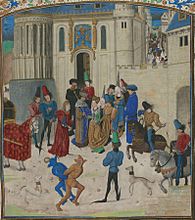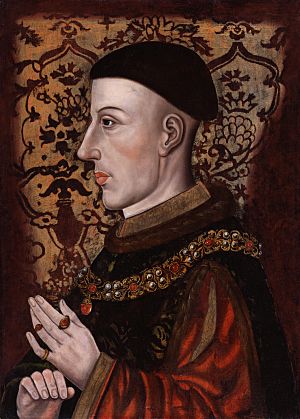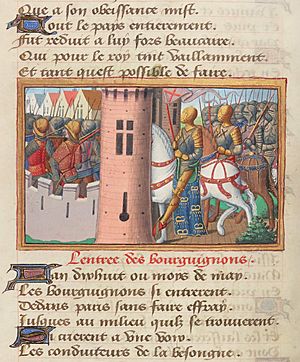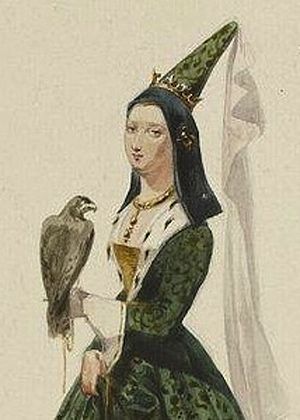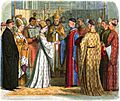Isabeau of Bavaria facts for kids
Quick facts for kids Isabeau of Bavaria |
|
|---|---|
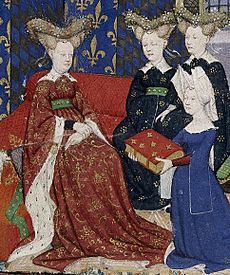
Queen Isabeau receiving Christine de Pizan's Le Livre de la Cité des Dames, c. 1410–1414. Illumination on parchment, British Library
|
|
| Queen consort of France | |
| Tenure | 17 July 1385 – 21 October 1422 |
| Coronation | 23 August 1389, Notre-Dame |
| Born | c. 1370 |
| Died | September 1435 Paris |
| Burial | October 1435 Basilica of St Denis |
| Spouse |
|
| Issue Detail |
Isabella, Queen of England Joan, Duchess of Brittany Marie, Prioress of Poissy Michelle, Duchess of Burgundy Louis, Dauphin of Viennois John, Dauphin of Viennois Catherine, Queen of England Charles VII of France |
| Father | Stephen III, Duke of Bavaria |
| Mother | Taddea Visconti |
Isabeau of Bavaria (also known as Isabelle or Elisabeth of Bavaria-Ingolstadt) was the Queen of France from 1385 to 1422. She was born around 1370 and passed away in September 1435. Isabeau became queen by marrying King Charles VI of France. Her time as queen was very important because her husband, King Charles, suffered from a long illness. This meant Isabeau had to take on a much bigger role in leading the country.
Contents
Becoming Queen: Isabeau's Early Life and Marriage
Isabeau's parents were Duke Stephen III of Bavaria-Ingolstadt and Taddea Visconti. Her mother brought a large dowry of 100,000 ducats (a type of gold coin) when she married. Isabeau was likely born in Munich, Germany, and was baptized Elisabeth. Her family, the Wittelsbachs, were very powerful in Germany.
In 1383, Isabeau's uncle suggested she marry King Charles VI of France. Charles was a young, active king who loved jousting and hunting. He was excited about getting married.

Charles VI's uncle, Philip the Bold, Duke of Burgundy, thought this marriage would create a strong alliance with the Holy Roman Empire. This alliance would be helpful against England. Isabeau's father agreed, even though he was a bit unsure. She was about 16 years old when she married Charles in 1385. They were married just three days after she arrived in France.
A Grand Royal Welcome: Isabeau's Coronation
Isabeau's coronation as Queen of France was a huge event on August 23, 1389. It included a very fancy parade into Paris.
The procession lasted all day. The streets were decorated with live scenes from history and religious stories. Over a thousand citizens stood along the route, dressed in green and red. Isabeau, who was pregnant, almost fainted from the heat during the five days of celebrations. To pay for this very expensive event, taxes were raised in Paris soon after.
King Charles VI's Illness and Isabeau's Growing Role
In 1392, King Charles VI had his first serious episode of mental illness. He fell into a coma for four days. Many people thought he wouldn't recover. His uncles, the Dukes of Burgundy and Berry, quickly took control of the government as regents.

Some people believed the King's illness was a sign of God's anger or the result of magic. Today, historians think he might have had a mental health condition that caused him to become confused and sometimes aggressive. When he was sick, Charles sometimes didn't recognize Isabeau. This made her very sad.
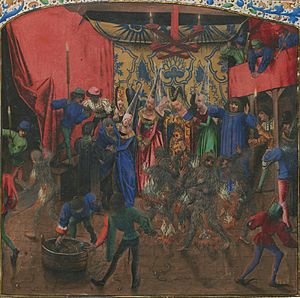
Charles had another long period of illness the next year, which lasted about six months. This pattern continued for the next 30 years. When he couldn't rule, his brother Orléans and his cousin John the Fearless (the new Duke of Burgundy) tried to take control.
Isabeau was only 22 when Charles first became ill. She had three children and had already lost two babies. Even though Charles's illness was difficult, Isabeau and Charles still cared for each other. They exchanged gifts and letters when he was well. However, she kept her distance during his severe periods of illness.
Isabeau's life is well-documented because Charles's illness put her in a powerful position. Historians don't even agree on what she looked like! She is described as either "small and brunette" or "tall and blonde." Even after living in France for years, she always spoke with a strong German accent.
Historians now see Isabeau as a skilled diplomat. She managed the difficult politics of the court with ease. When Charles became king at age 20, he dismissed his uncles and gave more power to his brother, Orléans. After Charles's first illness, tensions grew between Orléans and the royal uncles. Isabeau worked hard to keep the peace between these powerful groups, and she was often successful.

During a period when Charles was better, he made Isabeau the "principal guardian of the Dauphin" (the heir to the throne) until he turned 13. This gave her more political power on the council that ruled when the King was sick. Charles also made her co-guardian of their children in 1393. This decision divided power between Orléans and the royal uncles, causing more tension. As Charles's illness got worse, Isabeau became the leader of the regency council, giving her power over the royal dukes.
By 1402, Charles trusted Isabeau enough to let her settle arguments between the Orléanists and the Burgundians. He also gave her control of the royal treasury. When Philip the Bold died in 1404, his son John the Fearless became Duke of Burgundy. John continued the political fighting, wanting access to the royal money for his own interests. Isabeau sided with Orléans to protect the crown's money and her children's future.

John the Fearless accused Isabeau and Orléans of mismanaging money. He demanded money for himself. In 1405, John entered Paris with 1,000 knights. Orléans and Isabeau quickly left for a safe castle in Melun. John followed and captured the Dauphin, bringing him back to Paris. However, the Dauphin's uncle, the Duke of Berry, quickly took control of the boy. This event, known as the enlèvement of the dauphin (kidnapping of the dauphin), almost started a full-scale war. Isabeau helped calm the situation.
Major Conflicts: Assassination and Civil War
On November 23, 1407, Orléans was murdered by order of John the Fearless. John first denied it, but then admitted he did it for the Queen's honor. His uncles were shocked and forced him to leave Paris.
In March 1408, a theologian named Jean Petit gave a long speech at the royal palace. He argued that Orléans was a tyrant who used magic and was greedy. Petit said John should be forgiven because he had defended the King by killing Orléans. King Charles, who was ill during the speech, was convinced and pardoned John. But he changed his mind later.
Violence broke out again. Isabeau had soldiers patrol Paris. To protect her son, Dauphin Louis, she left the city for Melun again. In August, she arranged a grand entry for the Dauphin into Paris. Early the next year, Charles signed an order giving the 13-year-old Dauphin the power to rule when the Queen was away. During these years, Isabeau's main concern was her son's safety as she prepared him to be king. She made alliances to help him.
Shifting Alliances: Isabeau's Role in the Power Struggle
Isabeau's influence was very important in the power struggles. Both sides wanted control of Isabeau and her children. This often forced her to change sides, which led to some people criticizing her. She sided with the Burgundians from 1409 to 1413, then switched to the Orléanists from 1413 to 1415.
To ease tensions, two royal marriages were arranged in 1409. Isabeau's daughter Michelle married Philip the Good, John the Fearless's son. Isabeau's son, Dauphin Louis, married John's daughter Margaret. Before the wedding, Isabeau negotiated a treaty with John the Fearless. This treaty clearly defined her position and the family's importance to the throne.
The French Civil War and English Invasion
Despite Isabeau's efforts for peace, the Armagnac–Burgundian Civil War began in 1411. King Henry V of England took advantage of France's internal problems. He invaded the northwest coast and, in 1415, won a huge victory against the French at the Battle of Agincourt. Many French military leaders were killed or captured that day. John the Fearless, still fighting with the royal family, stayed neutral while Henry V conquered towns in northern France.

In December 1415, Dauphin Louis suddenly died at age 18. This made Isabeau's political position uncertain.
Her sixth and last son, Charles, became Dauphin at age 14. He was engaged to an Armagnac's daughter and favored the Armagnacs. At this time, the Armagnacs imprisoned Isabeau in Tours. They took her clothes, jewels, and money, and separated her from her younger children and ladies-in-waiting. She was freed in November with the help of the Duke of Burgundy. Isabeau stayed allied with Burgundy until the Treaty of Troyes in 1420.
Isabeau first became the sole regent, but in January 1418, she gave her power to John the Fearless. Together, Isabeau and John took control of Paris and the King. John took Paris by force on May 28, 1418, and many Armagnacs were killed. The Dauphin fled the city. Isabeau entered Paris with John on July 14.
Soon after becoming Dauphin, Charles made a truce with John. Charles then asked for a private meeting with John on September 10, 1419, promising his protection. However, the meeting was a trick to assassinate John. King Charles immediately disinherited his son. John's death ended the civil war. The Dauphin's actions led to more rumors about whether he was truly the King's son. His disinheritance set the stage for the Treaty of Troyes.
The Treaty of Troyes and Later Life
By 1419, Henry V of England had taken over much of Normandy. He demanded that the people living there swear loyalty to him. The new Duke of Burgundy, Philip the Good, allied with the English. This put huge pressure on France and Isabeau, who remained loyal to the King. In 1420, Henry sent a messenger to speak with the Queen. After this, Isabeau agreed to the terms of the Treaty of Troyes. France was left without a clear heir to the throne. Charles VI had disinherited the Dauphin, blaming him for John the Fearless's assassination. Charles of Orléans, the next in line, was a prisoner in London.
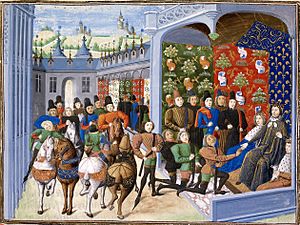
Since there was no official heir, Isabeau went with King Charles to sign the Treaty of Troyes in May 1420. The King was too ill to be there, so Isabeau signed for him. For many centuries, people blamed Isabeau for giving away the French crown because of this treaty. Under the treaty, Charles remained King of France. However, Henry V, who married Charles and Isabeau's daughter Catherine, would control the lands he had conquered. He would also govern France with the Duke of Burgundy and become Charles's successor. Isabeau was to live in English-controlled Paris.
Charles VI died in October 1422. Henry V had died earlier that same year. So, Henry's infant son by Catherine, Henry VI, was declared King of France according to the treaty. The Duke of Bedford acted as regent for the baby king. Rumors about Isabeau spread again, with some saying she lived in a "degraded state."
Isabeau was no longer involved in politics. She retired to live in the Hôtel Saint-Pol with her brother's second wife. She was with her ladies-in-waiting. Isabeau likely died there in September 1435. Her death and funeral were recorded by a monk from St Denis Abbey.
Isabeau's Reputation and Legacy
In the past, historians often saw Isabeau as a weak and indecisive leader. However, modern historians now recognize that she took on a very active leadership role for a queen of her time. She was forced to take responsibility because of King Charles's illness.
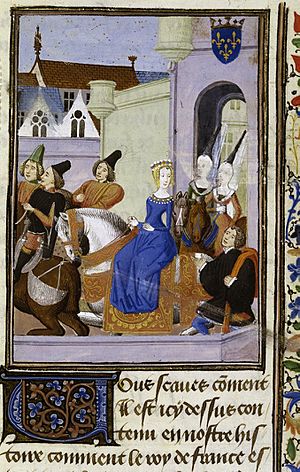
After the King became ill, many people believed his mental problems were caused by Isabeau's witchcraft. Rumors about magic at court spread as early as the 1380s. In 1397, Orléans's wife, Valentina Visconti, had to leave Paris because she was accused of using magic. The court of the "mad king" attracted magicians who promised cures. These magicians were often used as tools by the different political groups. Lists of people accused of bewitching Charles were made, and both Isabeau and Orléans were on them.
Isabeau was also criticized for wearing very expensive and fancy clothes, with lots of jewels and elaborate hairstyles. Some said her tall, braided hairstyles needed wider doorways to pass through! She was also accused of causing the civil war because she couldn't support just one political group. Some even called her "empty headed."
Isabeau's Support for the Arts

Like many members of the Valois family, Isabeau loved art and collected it. She especially loved jewels. She ordered many beautiful pieces made with a new technique called ronde-bosse. This method involved making gold pieces covered with enamel. Records show she ordered several fine gold artworks from Parisian goldsmiths.
In 1404, Isabeau gave Charles a spectacular ronde-bosse piece called the Little Golden Horse Shrine. It is now in a church in Bavaria. This statuette was a New Year's gift, a tradition Charles revived to show power and alliances. This golden piece weighs about 12 kilograms (26 pounds) and is covered with rubies, sapphires, and pearls. It shows Charles kneeling before the Virgin Mary and baby Jesus.
The medieval writer Christine de Pizan asked for the Queen's support at least three times. In 1402, she sent Isabeau a collection of her writings. In 1414, she gave the Queen an illuminated copy of her works. In her book The Book of the City of Ladies, Pizan praised Isabeau highly.
Isabeau was also very religious, which was important for a queen of her time. During her life and in her will, she gave property and personal items to important churches and convents.
Isabeau's Children
The birth of each of Isabeau's 12 children was well recorded. She had six sons and six daughters. Her first son, born in 1386, died as a baby. Her last son, Philip, born in 1407, lived only one day. Three other children died young. Only her youngest son, Charles VII, lived to adulthood. Five of her six daughters survived. Four of them married, and one, Marie (1393–1438), was sent to live in a convent at age four. She later became the head nun there.
Her first son, Charles (born 1386), was the first Dauphin, but he died as an infant. A daughter, Joan, born two years later, lived until 1390. The second daughter, Isabella (1389-1409), married Richard II of England at age seven. After his death, she married Charles, Duke of Orléans. The third daughter, another Joan (1391–1433), lived to age 42 and married John VI, Duke of Brittany. The fourth daughter, Michelle (1395–1422), was the first wife of Philip the Good. She died at age 27 without children. Catherine of Valois, Queen of England (1401–1437), married Henry V of England. After his death, she married Sir Owen Tudor.
Of her other sons, the second Dauphin was another Charles (1392–1401), who died at age eight from an illness. Louis, Duke of Guyenne (1397-1415), was the third Dauphin. He married Margaret of Nevers and died at age 18. John, Duke of Touraine (1398-1417), the fourth Dauphin, was the first husband of Jacqueline, Countess of Hainaut. He also died at age 18 without children. The fifth Dauphin, yet another Charles (1403-1461), became King Charles VII of France after his father's death. He married Marie of Anjou. Her last son, Philip, died as a baby in 1407.
Historians say Isabeau stayed close to her children when they were young. She traveled with them, bought them gifts, wrote letters, and arranged for her daughters to be educated. She didn't like it when her sons were sent to live in other households, which was common at the time. She kept in touch with her daughters after they married by writing letters often. She sent them out of Paris during a plague outbreak, staying behind herself with her youngest baby, John, who was too young to travel.
Images for kids
-
Miniature from a late 15th-century manuscript of Froissart's Chronicles showing Isabella's marriage to Richard II of England
-
Joan of France, shown in a late 17th-century or early 18th-century drawing, married John VI, Duke of Brittany
-
Michelle of Valois, shown here in a white hennin (from the center panel of a Flemish triptych), was first wife to Philip the Good
-
Catherine of Valois, meeting Henry V of England, shown in a 19th-century woodcut, printed by Edmund Evans
-
Charles VII of France shown in a mid-15th-century portrait by Jean Fouquet
Ancestry
| Ancestors of Isabeau of Bavaria | |||||||||||||||||||||||||||||||||||||||||||||||||||||||||||||||||||||||||||||||||||||||||||||||||||||||||||||||||||||||||||||||||||||||||||||||||||||||||||||||||||||||||||||||||||||||||||||||||||||||||||||||||||||||||||||||||||||||||||||||||||||||||||||||||||||||||||||||||||||||||
|---|---|---|---|---|---|---|---|---|---|---|---|---|---|---|---|---|---|---|---|---|---|---|---|---|---|---|---|---|---|---|---|---|---|---|---|---|---|---|---|---|---|---|---|---|---|---|---|---|---|---|---|---|---|---|---|---|---|---|---|---|---|---|---|---|---|---|---|---|---|---|---|---|---|---|---|---|---|---|---|---|---|---|---|---|---|---|---|---|---|---|---|---|---|---|---|---|---|---|---|---|---|---|---|---|---|---|---|---|---|---|---|---|---|---|---|---|---|---|---|---|---|---|---|---|---|---|---|---|---|---|---|---|---|---|---|---|---|---|---|---|---|---|---|---|---|---|---|---|---|---|---|---|---|---|---|---|---|---|---|---|---|---|---|---|---|---|---|---|---|---|---|---|---|---|---|---|---|---|---|---|---|---|---|---|---|---|---|---|---|---|---|---|---|---|---|---|---|---|---|---|---|---|---|---|---|---|---|---|---|---|---|---|---|---|---|---|---|---|---|---|---|---|---|---|---|---|---|---|---|---|---|---|---|---|---|---|---|---|---|---|---|---|---|---|---|---|---|---|---|---|---|---|---|---|---|---|---|---|---|---|---|---|---|---|---|---|---|---|---|---|---|---|---|---|---|---|---|---|---|---|---|
|
|||||||||||||||||||||||||||||||||||||||||||||||||||||||||||||||||||||||||||||||||||||||||||||||||||||||||||||||||||||||||||||||||||||||||||||||||||||||||||||||||||||||||||||||||||||||||||||||||||||||||||||||||||||||||||||||||||||||||||||||||||||||||||||||||||||||||||||||||||||||||
See also
 In Spanish: Isabel de Baviera-Ingolstadt para niños
In Spanish: Isabel de Baviera-Ingolstadt para niños


